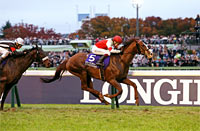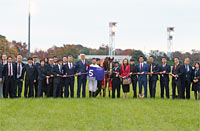2015 News
Data Analysis for the "2015 Japan Cup (G1)"A big race in the global spotlight Of the last 20 winners of the Japan Cup, the only ones not to have won a domestic or overseas G1 race since the previous year were Tap Dance City in 2003 and Screen Hero in 2008. But both of these had won JRA G2 races since October of the year in question. Partly because of the generous prize money – the largest in Japan and one of the largest in the world – wins in world-class G1 races or higher-ranking prep races are almost a prerequisite for any horse aiming to make a serious challenge in this race. So which of this year’s entrants will outshine the customary array of top Japanese and overseas horses to take this high-profile race, gaining worldwide renown in the process? This time, let’s analyze characteristics shared by strong performers in this race from results over the last 10 years. No success for foreign-trained horses since 2006 Of 30 top 3 finishers over the last 10 years, the only foreign-trained horses were 2005 winner Alkaased and Ouija Board, 3rd in 2006, yielding a meager top 3 ratio of 4.7%. In fact, no foreign-trained horse has finished in the top 3 for the last eight years in a row, so perhaps our expectations of foreign-trained horses should be on the low side. [Table 1] [Table 1] Performance by training country (last 10 years)
Actually, both 2005 winner Alkaased and 2006 3rd-placed Ouija Board were trained in the UK, and both had won G1 races since June of the year in question. So when comparing foreign-trained horses, it may be useful to check the training country and the track record since June. [Table 2] [Table 2] Foreign-trained horses with top 5 finishes, listed by training country and highest G1 finish since June that year (last 10 years)
Strong showing from horses with success in Tokyo G1 races Of 28 Japan-trained top 3 finishers over the last 10 years, all except 2008 winner Screen Hero and Tosen Jordan (3rd in 2013) had experienced a top 4 finish in G1 race held at Tokyo Racecourse since the previous year. Horses without this experience have struggled, managing a top 3 ratio of only 3.4%. As well as horses with no experience of success at Tokyo, those with experience of success only in Tokyo G2 or G3 races may perhaps be overlooked. [Table 3] [Table 3] Performance of Japanese horses by experience of a top 4 finish in Tokyo G1 races since the previous year (last 10 years)
Younger horses excel A look at the performance of Japanese horses by age over the last 10 years show that “4-year-olds” have the highest win ratio, top 2 ratio and top 3 ratio, followed by “3-year-olds” and “5-year-olds,” respectively. By contrast, horses aged six and up have produced no winners and have achieved nothing special in success ratios either. When comparing runners from different age groups, our eye should be on relatively young horses around the age of four. [Table 4] [Table 4] Performance of Japanese horses by age (last 10 years)
Check the finish and favoritism last time out Of Japanese horses most recently contesting JRA races, none has finished in the top 2 when the finish in that race was “7th or lower,” and their top 3 ratio is also poor at 4.7%. It seems we can have little hope of a rebound performance by runners badly beaten last time out. [Table 5] [Table 5] Performance of Japanese horses by finish in the last race when it was JRA (last 10 years)
Again, of horses most recently seen in JRA races, none that was “5th favorite or lower” in that race has won this one; in fact, runners coming with that kind of form have a top 3 ratio of only 7.0%. When comparing the details of the previous outing, our attention should be on both the finish and the favoritism in that race. [Table 6] [Table 6] Performance of Japanese horses by favoritism in the last race when it was JRA (last 10 years)
Inner brackets have a slight edge in recent years Turning to performances by bracket number over the last six years, “Brackets 1-3” have produced better success ratios than “Brackets 4-8” – for example, brackets “1” and “3” have the best top 3 ratio. [Table 7] [Table 7] Performance by bracket number (last 6 years)
If we then narrow this down to horses with no experience of winning G1 races at Tokyo since the previous year, horses from “Brackets 4-8” have produced no winners here, with a top 3 ratio of only 5.4%. When comparing horses with no experience of Tokyo G1 wins since the previous year, it would seem best to focus particularly on the inner brackets. [Table 8] [Table 8] Performance by bracket number of horses with no Tokyo G1 wins since the previous year (last 6 years)
Seek out the winner! Every winner over the last six years had experienced a top 2 finish in Tokyo G1 races since the previous year, and all of them were five years old or less. Other points shared by these six is that their previous outing was a G1 race held since October that year (Shuka Sho, Kikuka Sho (Japanese St. Leger) or Tenno Sho (Autumn)), and that they finished no lower than 6th and were among the top 4 favorites in that race. Horses most recently seen in the Shuka Sho, Kikuka Sho or Tenno Sho (Autumn) could be seen as leading contenders to win this race if they clear the conditions set in Tables 3 to 6. [Table 9] [Table 9] Winners’ highest G1 finish at Tokyo since the previous year, age, and finish and favoritism last time out (last 6 years)
(Data analysis by Masaya Ibuki) |
|
||||||||||||||||||||||||||||||||||||||||||||||||||||||||||||||||||||||||||||||||||||||||||||||||||||||||||||||||||||||||||||||||||||||||||||||||||||||||||||||||||||||||||||||||||||||||||||||||||||||||||||||||||||||||||||||||||||||||||||||||||||||||||||||||||||||||||||||||||||||||||||||||||||||||||||||||||||||||||||||||||||||||



















